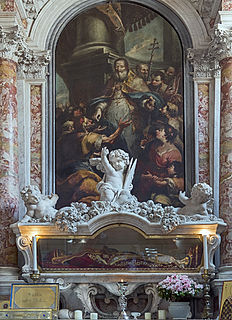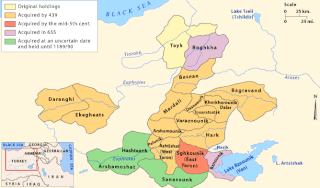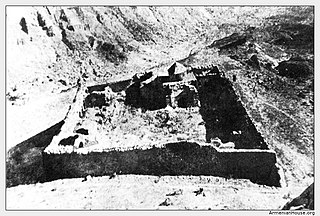
John the Merciful, also known as St John the Almsgiver, John the Almoner, John V of Alexandria, John Eleymon, and Johannes Eleemon, was the Chalcedonian Patriarch of Alexandria in the early 7th century and a Christian saint. He is the patron saint of Casarano, Italy and of Limassol, Cyprus.
Imitation of God is the religious precept of Man finding salvation by attempting to realize his concept of supreme being. It is found in ancient Greek philosophy and several world religions. In some branches of Christianity, however, it plays a key role.

Ming the Merciless is a fictional character who first appeared in the Flash Gordon comic strip in 1934. He has since been the main villain of the strip and its related movie serials, television series and film adaptation. Ming is depicted as a ruthless tyrant who rules the planet Mongo.

Taron was a canton of the Turuberan province of Greater Armenia, roughly corresponding to the Muş Province of modern Turkey.

The Catholic Church in Ukraine is part of the worldwide Catholic Church, under the spiritual leadership of the Pope in Rome.

Why Me? is a 1990 American caper comedy film directed by Gene Quintano and starring Christopher Lambert, Kim Greist, Christopher Lloyd, and J. T. Walsh. The screenplay is credited to Donald E. Westlake and Leonard Maas Jr., and is based on the fifth book in Westlake's series of John Dortmunder novels.

John III the Terrible, also John III the Brave was Voivode of Moldavia between February 1572 and June 1574.
Merciless may refer to:
Catholicos Khachig I was the Catholicos of the Armenian Apostolic Church between 973 and 992.

Akhtala, also known as Pghindzavank is a 10th-century Armenian Apostolic monastery located in the town of Akhtala in the marz of Lori, 185 kilometers (115 mi) north of Yerevan and 87 kilometers south of Tbilisi. The monastery is currently inactive. The fortress played a major role in protecting the north-western regions of Armenia (Gugark) and is among the most well preserved of all in modern Armenia. The main church at the compound is famous for its highly artistic frescoes, which cover the inside walls, the partitions, and the bearings of the building. The modern name of Akhtala was first recorded in a royal decree of 1438. The etymology of the name Akhtala is believed to be of Turkic origin, meaning white glade. The original Armenian name of the settlement where the monastery is built is Pghindzahank, which means copper mine.

Hovhannavank is a medieval monastery located in the village of Ohanavan in the Aragatsotn Province of Armenia. The monastery stands on the edge of the Kasagh River canyon, and its territory is adjacent to the village of Ohanavan. The deep gorge is carved by the Kasagh River.
Varaztirots II Bagratuni was an Armenian nakharar from the Bagratuni family, the son of Smbat IV Bagratuni. He was marzpan of Armenia c. 628, fled to the Byzantine Empire soon thereafter and was exiled for several years to Africa for his participation in a plot against Heraclius. On his return c. 645/6, he was named curopalates and presiding prince of Armenia, but died before being formally invested.

Ashot III was a king of Armenia, ruling the medieval kingdom of Armenia from 952/53–77. Known as Ashot III the Merciful and acknowledged by foreign rulers as the Shahanshah of Mets Hayk', he moved his royal seat of residence to Ani and oversaw its development and of the kingdom as a whole. Armenia reached the height of its golden era during his reign and that of his sons and successors, Smbat II (977–89) and Gagik I (990–1020).
Heinrich Gelzer was a German classical scholar. He wrote also on Armenian mythology. He was the son of the Swiss historian Johann Heinrich Gelzer (1813–1889). He became Professor of classical philology and ancient history at the University of Jena, in 1878. He wrote a still-standard work on Sextus Julius Africanus. He worked out the chronology of Gyges of Lydia, from cuneiform evidence, in an 1875 article.

The Mausoleum of Kara Koyunlu emirs or Mausoleum of Turkmen emirs also known as Emir Pir-Hussein Mausoleum, is a Turcoman mausoleum erected in 1413 and located in the village of Argavand, Ararat Province, on the outskirts of the Armenian capital Yerevan.

Eugeniusz Marcin Kazimirowski was a Polish painter member of the realism movement. He is best known for the first depiction of the Divine Mercy image in 1934, based on a request from Faustyna Kowalska and her confessor Michael Sopoćko.

The Bagratuni or Bagratid dynasty was an Armenian royal dynasty which ruled the medieval Kingdom of Armenia from c. 885 until 1045. Originating as vassals of the Kingdom of Armenia of antiquity, they rose to become the most prominent Armenian noble family during the period of Arab rule in Armenia, eventually establishing their own independent kingdom. Their domain included regions of the Kingdom of Armenia such as Shirak, Bagrevand, Kogovit, Syunik, Lori, Vaspurakan, Vanand, Taron, and Tayk. According to the modern historian Cyril Toumanoff, they were the progenitors of the Georgian royal Bagrationi dynasty.
Bagratuni may refer to:

Holy Saviour Monastery of Julfa was an Armenian Apostolic monastery, located north-west of Jugha cemetery at the end of the gorge, 3 km away from the cemetery, on that slope of a high mountain. In the southern part of the monastery, at the foot of the Magharda mountain range, the Araks River flows.

Heroes and Villains: The True Story of the Beach Boys is a 1986 book by American journalist Steven Gaines that covers the history of the Beach Boys. The contents are focused on the band members' private lives and personal struggles, with little commentary reserved for the music itself. Coverage spans the group's early years to Dennis Wilson's death in 1983. It was the third major biography written about the band, following David Leaf's The Beach Boys and the California Myth (1978) and Byron Preiss' The Beach Boys (1979).